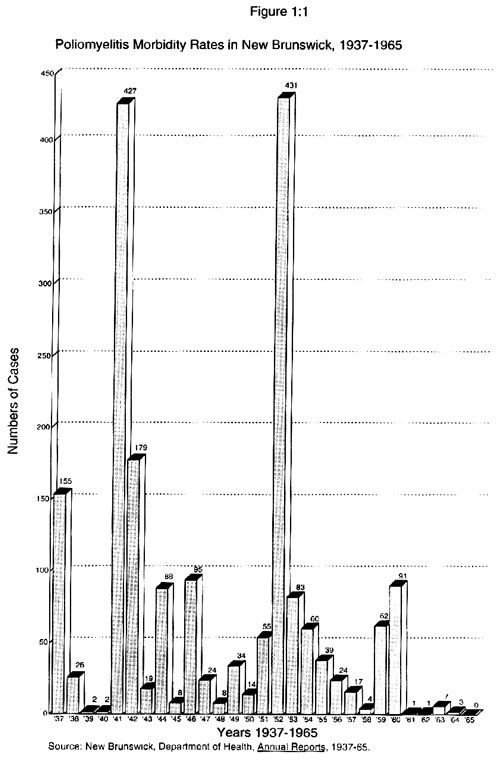Photocopies of this thesis are available for $30, postage included,
from the address below:

"DISEASE AND DISABILITY
Poliomyelitis, Rehabilitation and Social Reform
for Disabled Persons in New Brunswick,1941-1955"
MA Thesis
University of New Brunswick
Department of History
1994
Dr. Ernie Forbes, Supervisor
Photocopies of this thesis are available for $30, postage included,
from the address below:

Polio epidemics forced the New Brunswick government to change its health care policies and enter the field of medical rehabilitation. The 1941 epidemic, in particular, was significant; 65 per cent of the 427 victims suffered from paralysis, and 53 of these predominantly young persons required hospitalization at the Fredericton Victoria Public Hospital. Indeed, the epidemic compelled the Department of Health to establish a Polio Clinic in the capital city, where early rehabilitation began. In 1952, when another severe epidemic intensified the impact of polio, the condition of the old Polio Clinic became a powerful political issue in an election held that year. It was an important factor in the defeat of the incumbent Liberal party, and committed the Conservative government to building a new Polio Clinic and Health Centre, opened in 1955.
By the mid-1950s, the polio experience was acting as the nucleus for
the extension of medical services to people with other kinds of disability,
in a new provincial rehabilitation program. Polio's critical contribution
to rehabilitation in New Brunswick left a legacy to all disabled persons
as the peak years of the disease passed.

Chapter One
The New Brunswick Polio Epidemics, 1941-2: A Catalyst
for Change
Chapter Two
Changing Attitudes: Poliomyelitis and Disabled Persons
in the 1940s
Chapter Three
Polio, Power and Politics: The 1952 New Brunswick Election
Chapter Four
Rehabilitation Redefined: The new Polio Clinic and Health
Centre, 1951-55
Conclusion
Bibliography
| Gillian A.W. Liebenberg 711, Valleyview Street Fredericton E3B 4E9 New Brunswick Canada Tel: (506) 454-6547 Fax: (506) 454-3663 Email: gliebenb@nb.sympatico.ca |
Updated: November 6, 2002